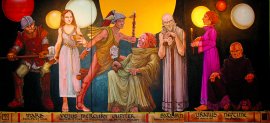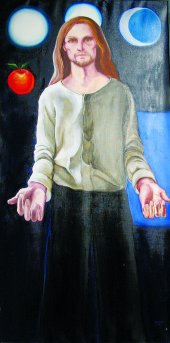 On
a small, dark stage, Venus slowly materializes, walking silently
toward us in a diaphanous robe, holding a chalice and a sheath of
wheat, her eyes distant. Jupiter, looking like Dionysus, sits on an
invisible chair holding a jester's toy, laughing at something he's
just heard from sly Mercury, who slowly floats by. Neptune the mystic
crouches, bare-headed, waiting, looking beyond us.
On
a small, dark stage, Venus slowly materializes, walking silently
toward us in a diaphanous robe, holding a chalice and a sheath of
wheat, her eyes distant. Jupiter, looking like Dionysus, sits on an
invisible chair holding a jester's toy, laughing at something he's
just heard from sly Mercury, who slowly floats by. Neptune the mystic
crouches, bare-headed, waiting, looking beyond us.
These figures are not actors in any play, but personalities painted in acrylic on canvas. Bill Hannan is introducing us to dozens of the characters from his world in the current exhibition at MidCoast Gallery West in Rock Island. A reception is scheduled for Friday.
He has interpreted figures from theatre, opera, history, and mythology, with a strong sense of their many-layered personalities.
Take, for instance, the large painting called The Planets, partially described above. Rather than portraying Gustave Holst's music in swirling abstract forms or with only orbiting spheres, Hannan has taken each planet and personified it with a vibrant, detailed take on the charismatic Roman deities, using his accomplished memory of the human form to portray them.
Mars, the bringer of war, is an armed and heavy-booted warrior waiting with a battle ax. Saturn is painted as an ancient and wizened prime minister standing in a long robe near Jupiter. Uranus, the magician, is seen as a serene and beautiful woman of intuition and power - all women in Hannan's portraits are strong - walking serenely and holding a small, glowing, egg-shaped orb on a long wooden stem. She moves wisely and confidently among the others. Every planetary character is concisely drawn, and created without a model, like Athena springing fully formed from the head of Zeus.
Across the gallery hangs The Hands of St. Joseph, looking at first like a standard depiction of Christ with long hair, far-seeing eyes, a white smock, and outstretched hands. When we see the title, we are suddenly confronted with his earthly father. Numerous portraits of St. Joseph are scattered through art history, and he is usually shown as a long-bearded elderly figure, a mute attendant on the scene near the Holy Family. Here he is young and vital, lightly bearded with chiseled cheekbones, and haloed by three moons in various phases. He seems industrious and earthly wise, a humble servant of the everyday, like Velázquez's The Water-Carrier of Seville. His eyes, though, are haunting, and look deep into the distance. His hands, we notice, seem to be holding nothing visible. A very red apple hovers in mid-air.
Nearby is Hannan's Our Lady of St. Blick, a tribute to the departed art store, where the artist and this reviewer often met. Seated on an invisible throne and holding the wise infant Christ in her lap, the Mother of all Creativity, with a purple robe and a golden halo around her Egyptian hair, looks out at us with penetrating eyes, sorrowfully and calmly. The powerful young Christ child seems to be listening to a distant music.
Painted in gouache, calligraphic writing frames the edges, spelling "Mother of Jesus, Please Keep Us in the Apple of Your Eye." The image looks back to medieval illuminations in its technique and execution. Hannan's work has a quality of the late Middle Ages in its simplicity, humility, and directness.
Close by on the wall are four paintings in primary colors, of personas with red and blue and yellow faces. Situated in atmospheric backgrounds, these portraits seem like created characters from a Star Trek TV show with their slightly pointed ears - somewhat strange yet also familiar in their human facial expressions. Titled after their dominant colors, they can be seen as fine examples of drawing and color theory, and as further characters in Hannan's authored paintings. Each again is succinct, complete in itself, confident, yet in almost brutal abstract color combinations. His drawing, though, is never in doubt.
Both imagined and realistic, Hannan's actors express their inner qualities through the artist's line and color. As with any portrait artist, proportional accuracy plays the most important role, but the remainder is drawn from the creator's empathy and understanding, describing through line the inhabitation of an eye, the mood, and the personality of the subject. Technique helps immensely, but a true portrait is more.
The strength of Hannan's work is his familiarity with the undercurrent of thought and emotion, of inner life taking place beneath surface appearances. This is expressed in the painting in the small details we generally don't notice - the barest flicker of line and shadow, a nuance of color, a subtle expression, or a grand theatrical stance.
 And
Hannan's work often goes beyond portraiture. As an artist who draws
well, he often plays with or manipulates reality, using combinations
of forms and techniques to illustrate ideas. Whether by design or
accident, a genuine sense of personality emerges out of the artist's
mind and emotions.
And
Hannan's work often goes beyond portraiture. As an artist who draws
well, he often plays with or manipulates reality, using combinations
of forms and techniques to illustrate ideas. Whether by design or
accident, a genuine sense of personality emerges out of the artist's
mind and emotions.
His characters have suffered and yet remain resilient. Silence often surrounds them.
Even his two self-portraits seem largely imagined, improvised from the mirror. One is from his youth, looking like a young Clark Kent in bright Matisse colors, and another from near-present, with a striking blue face and opaque glasses.
At the right end of the exhibit is a soft abstract painting called Om, with an open white space vaguely resembling a lighted figure surrounded by a soft yellow glow. Below in calligraphic script is the title itself. This is the only work where the figure is absent. We come away missing a well-wrought image.
There are other attractions and enjoyments: several illustrations for storybooks and their covers; numerous images of painted ballet heroines, drawn and then scanned and colored in a digital format; a melancholy centurion surrounded by a whirlwind of words; a medieval hawking lady of sadness and patience in a circular forest; and some pencil and pastel drawings of beauty and draftsmanship.
One such drawing is called Woman with a Sphere, in colored pencil. A pale mysterious woman of calm strength, with pale green eyes and big golden curly hair, rests her hand on a round sphere. Her eyes look as if she is waiting, longing for a revelation. Sitting in a red dress covered in strange magical symbols, she is set in a red stage with peculiar writing all around in the air, filling the space like music. The drawing perfectly describes her character's introspective nature with a sure handling of line and added touches of color. But at the lower right of the image, as if we are looking through the curled-back corner of the drawing itself, another sphere is revealed. Here is the mystical connection with the unknown.
Grounded in the human figure, using stages and sets as backgrounds, painting with an experienced hand, but not bound by reality, Hannan has created dramatic worlds, like the writer William Faulkner imagined and populated his own county. The people Hannan describes are natives of mysterious worlds fully playing the roles they have been given.
A reception for the exhibit will be held from 7 to 9 p.m. on Friday, September 21, at MidCoast Gallery West, 1629 Second Avenue in Rock Island.










